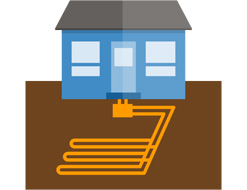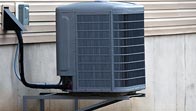Geothermal systems
Geothermal energy is clean and renewable. It is generated from the energy stored in the earth, which is developed to meet household heating and air-conditioning needs.
Purchasing a geothermal system
A geothermal system is an energy-efficient solution that may be an excellent option to heat and air-condition a new home, replace an aging system or lower heating costs.

Benefits
- Several systems in one: a geothermal system doesn’t only provide household heating. It may also be set up to air-condition your home and preheat the water in your water heater and pool.
- Lower heating costs: the system will help you save up to 60% on heating costs as compared to a conventional electric resistance heating system.
- Ecoresponsible heating: a geothermal system consumes less electricity and, by the same token, helps reduce energy demand in peak periods.
- Sustainable solution: the system’s underground loop has a service life of over 50 years and the heat pump has a service life of approximately 20 years.
- Easy maintenance: a geothermal system is just as simple to maintain as a conventional forced-air electric heating system combined with an air-conditioning unit.
- Proven technology: the system has been tried and tested for over 30 years and the technology continues to evolve.
Constraints
- Cost: Several factors impact the price but, for an average home, the cost of the system will vary between $20 000 and $40 000.
- Distribution system: installing a geothermal system in an existing house may require modifying the heating or air-conditioning distribution system (e.g. installing or modifying air ducts or adding baseboard heaters).
- Drilling: the cost to install the underground loop varies according to the type of soil.

Save money and energy
Get financial assistance to implement energy efficiency measures in your home. Discover the LogisVert Program
How geothermal systems work
Geothermal systems capitalize on the temperature just a few metres below the earth’s surface, which, in Québec, averages 10°C. In summer, the heat pump extracts warm air from the house, transfers it to the ground and then returns cool air to the house. In winter, the heat pump extracts the heat stored in the ground and transfers it to the house.
Three components of a geothermal system: a heat pump, an underground loop that warms or cools a circulating fluid, and a distribution system that circulates warm or cool air throughout the house
1. Heat pump
The heat pump is connected to the distribution system and transfers heat between the ground loop and the house. In winter, it concentrates heat from the ground loop and transfers it to the house. In summer, it sends heat from the house into the underground loop and cools the house.
2. Underground loop
In a geothermal system, the ground loop serves as the heat source and heat sink. The ground loop can be either open or closed.
Closed-loop system
In a closed-loop system, a fluid mixture of antifreeze and water circulates through the ground loop and heat pump.
Four types of closed-loop systems:




Open-loop system
In an open-loop system, groundwater from a well serves as the heat source and heat sink. The pump draws water from the well and then extracts or transfers the heat (depending on the season) through a heat exchanger. The water is then discharged into the earth, usually through a return well.

3. Distribution system
The distribution system may be a central forced-air or hot water system or a hybrid system involving hydronic floor heating, for example. But only a system with air ducts can provide air-conditioning in every room. If your home is equipped with a hydronic system (radiant heating or other type of system), you must have air ducts installed for central air-conditioning.



